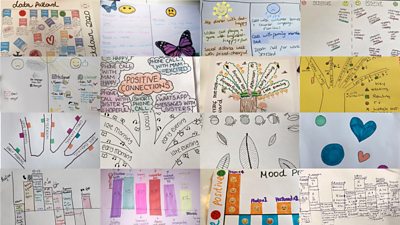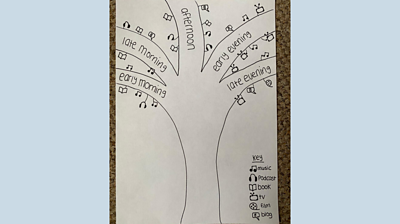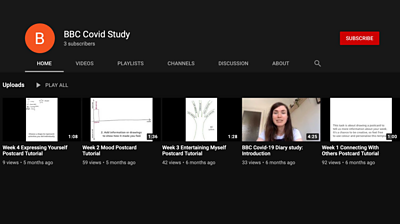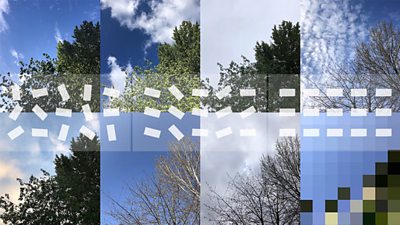
In part two of our series on researching life under lockdown, we explain how we incorporated a new, experimental methodology into the study and what we learned in the process. You can read about our rationale and methodology for the study in part one and our findings from the study in part three.
- ±«Óãtv R&D - Life under lockdown - studying uses of media and technology
- ±«Óãtv R&D - Life under lockdown - the value and role of technology and media in a pandemic
Designing a new cultural probe
Many design researchers will be familiar with cultural probes, a method originally attributed to Gaver, Dunne, and Pacenti. The technique asks participants to self-document over a set period using various creative tasks such as photographs or diary entries. Cultural probes are used to gain a greater depth of understanding of people's contexts, values and experiences around a certain topic.
In addition to more traditional cultural probes such as letter writing, photographs and diaries, we decided to add an additional activity. We were inspired by the 'data postcards' designed and sent by and : two information designers and creators of the '' project. The designers created intricately designed postcards to send between the UK and USA, telling each other about their week.
This project inspired us to think: how could we incorporate this approach into a diary study? Our idea was that we would ask participants to collect data on a different theme each week, which they would visualise into a data postcard at the end of every week.
We hoped this task would:
- provide a visual method of data collection, which we hypothesised would help us to identify trends and patterns in people's behaviour,
- help participants to analyse and reflect on their own behaviour change during lockdown,
- add an enjoyable, creative task for the participants to do in a relatively long study,
- trial a new method of data collection.
Choosing a focus for the 'data postcard' tasks
A preliminary survey was carried out to better direct our study towards the values that were particularly important to people during lockdown. The results of this survey informed the study tasks. The four themes we chose were: 'connecting with others', 'wellbeing', 'entertaining myself' and 'expressing myself'.

A completed data postcard.
For each week, we wanted participants to visualise their data in a slightly different way. After settling on these four topic areas, we designed the data visualisation tasks in group sessions. We each took a postcard theme and designed its contents, thinking about the balance between what information we wanted to learn and the level of complexity and effort required to complete the task.
Communicating the data postcard task to participants
The nature of the lockdown conditions and working from home practices meant that we weren't able to meet participants in person or send physical objects in a cultural probe pack, which is a popular method in qualitative data collection.
The challenge for us as researchers was to communicate complex tasks to participants both remotely and asynchronously. First of all, we trialled the probes and postcard tasks within our department, sending-out tasks in Slack messenger to mimic the WhatsApp conversations participants would have with the researcher. This helped us to refine the task instructions we sent to participants, making sure they were as clear as possible.
As it was a visual, drawing task, we decided that a good way to explain the data postcard task to participants would be through instructional videos. We created a YouTube channel where these were uploaded each week. Participants were sent links to these as well as instruction cards, to be sent as an image in WhatsApp.

YouTube channel accessed by participants to watch instructional videos.
What worked well
What made the postcard task different to a traditional diary study was that it was the participants themselves who were collecting their own data, and reflecting and interpreting it at the end of each week, rather than the researchers doing this.
A strength of this approach was the feeling of participation created for the participants; we weren't just studying them, they were actively helping shape the research. Also, due to the structure of the data collection, participants had time to consider the concepts we were investigating more fully and reflect on their experiences over a week.
Another benefit was that it reduced the likelihood of the researchers misinterpreting the individual data points. Of course, we cannot always rely on individuals accurately describing or interpreting their own behaviours.
Some participants were asked to feedback on the study and how they found completing the tasks. Many said they enjoyed the data postcard task because it was creative and that the drawing element of the task was relaxing. It had a therapeutic effect for some, enabling them to reflect on their week. However, some found the task time-consuming and that it took longer than expected.
Limitations of this method
One limitation to the data postcards method was that while the data drawings looked nice as artefacts, in most cases, they did not further our insights. The most valuable data came via the individual data points, which individuals logged as part of their daily diary anyway.
After having drawn the postcard, participants were required to answer a set of reflection questions related to the theme, and this proved to be more valuable than the postcard itself. The written answers were more in-depth and communicated the participants' experiences clearly. However, it could be argued that the postcard activity did serve to get participants thinking and reflecting on the weekly theme and as a result, generated richer responses if there had been no postcard or drawing task.
We saw that sometimes having the themed weeks influenced participants' behaviours for the week. We noticed this, especially in week four (the 'expressing myself' theme), which perhaps was not as neutral as the other themes. For example, participants made judgements about whether they had expressed themselves enough throughout the week, and some seemed to take up new behaviours we hadn't seen in the previous weeks to meet the task.
Also worth noting is that participants completed their postcards to varying levels of detail. This made it difficult for us to look for patterns in behaviour. Some omitted information asked of them such as frequency on the mood postcard, and some reported only one or two events in their postcards, even if they had mentioned other relevant things in their daily diaries that week. This was especially seen in weeks three and four, where I imagine the participants were becoming fatigued.
Conclusion
As a whole, the study gave a great deal of insight into different people's experiences during the Covid-19 crisis in the UK. It was also a really good demonstration that a research study can be an enjoyable experience to participate in if designed well. This particular method seemed to work because it was a creative stimulus, which engaged participants and gave an opportunity to express themselves and self-reflect throughout the study. In future, when designing a data postcard task, researchers should ensure it provides unique value as a data source as well as being a tool for engagement. Using data postcards as a data collection method should therefore be designed in a way to make the time taken to complete worthwhile, rather than simply added as a novel feature or a fun task for participants to do.
- -
- ±«Óãtv R&D - Audience Research
- ±«Óãtv R&D - Life under lockdown - studying uses of media and technology
- ±«Óãtv R&D - Life under lockdown - the value and role of technology and media in a pandemic
- ±«Óãtv R&D - Digital Wellbeing
- ±«Óãtv R&D - Human Values: Understanding Audiences Beyond Demographics
- ±«Óãtv R&D - Psychometrics for Human Values: a new way to measure success and value
- ±«Óãtv R&D - Being Healthy & Safe: Human Value Priorities During a Pandemic
- ±«Óãtv R&D - Designed for Life: Understanding Memories and Wellbeing in a Digital World
- ±«Óãtv R&D - Designed for Life: Making a Creative Memory Study for Young People
-

Internet Research and Future Services section
The Internet Research and Future Services section is an interdisciplinary team of researchers, technologists, designers, and data scientists who carry out original research to solve problems for the ±«Óãtv. Our work focuses on the intersection of audience needs and public service values, with digital media and machine learning. We develop research insights, prototypes and systems using experimental approaches and emerging technologies.
